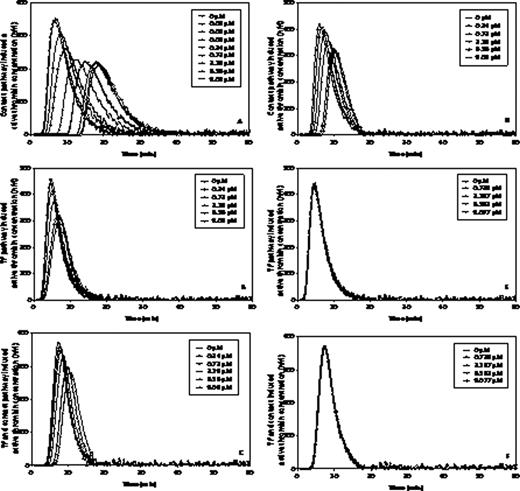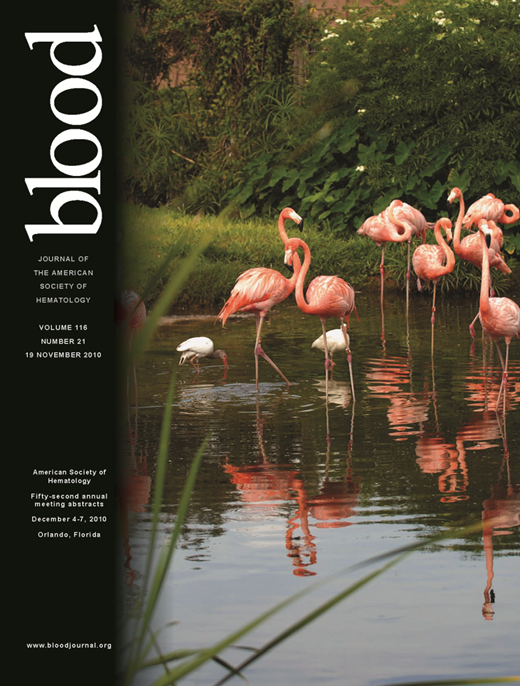Abstract
Abstract 3336
The search for new anticoagulants is a major challenge in medicine. Contact factors have never been considered as interesting targets for the development of new anticoagulant agents since they are not required for in vivo coagulation (i.e. deficiencies affecting these factors do not cause excessive bleeding). The discovery that FXI and FXII deficiency protects against thrombosis without causing spontaneous bleeding in mice makes FXII a unique and ideal target for drug design. We demonstrated in vitro that Ir-CPI, a 67 amino acids recombinant Kunitz-type protein from Ixodes ricinus, specifically interacted with activated human contact phase factors (FXIIa, FXIa, and kallikrein).
The goal of this study was to investigate the potential anticoagulant and antithrombotic efficacy of Ir-CPI.
The effects of Ir-CPI were investigated on the thrombin activity during the coagulation process in human plasma using the CAT method. Three different inducers were employed to specifically trigger the coagulation pathways and to generate thrombin. A standard concentration of 5 pM TF with 4 μM PL and 16.7 mM CaCl2 was used to activate the TF pathway whereas a lower TF concentration of 1 pM with 4 μM PL and 16.7 mM CaCl2 was selected for stimulating the TF pathway in combination with the contact phase pathway through a thrombin-mediated positive feedback. The contact phase pathway was also triggered alone by ellagic acid, PL and 16.7 mM CaCl2 (25-fold diluted APTT reagent Actin FS). The effect of Ir-CPI on venous thrombus formation was assessed using a rat thrombosis model induced by complete venous stasis in the posterior vena cava and FeCl3 topical application on the outer vessel wall.
When stimulating plasma coagulation trough the contact pathway, Ir-CPI caused a concentration-dependent prolongation of the lag time and the Tmax and a concentration-dependent decrease in the Cmax compared to the control curve (i.e. without inhibitor). When the coagulation cascade was triggered by the TF pathway (5 or 1 pM TF), only a slight concentration-dependent decrease of the Cmax and a concentration-dependent prolongation of the lag time and the Tmax were observed. For comparison purpose, the effects of the specific competitive FXIIa inhibitor corn trypsin inhibitor (CTI) were also investigated using the three same inducers than for Ir-CPI. For the contact pathway, a concentration-dependent decrease of the Cmax and a concentration-dependent prolongation of the lag time and the Tmax were found. When stimulating the TF pathway (5 or 1 pM TF), no modification of the thrombin generation curves was observed with the tested concentrations of CTI. When comparing the results of the two inhibitors acting trough the delay of the contact pathway, we found that Ir-CPI was about 30-fold more potent than CTI.
We further evaluated the antithrombotic effect of Ir-CPI on a rat venous thrombosis model induced by endothelial damage and vessel ligation, close to the physiological venous thrombus formation in humans. We showed that Ir-CPI reduced thrombosis in a dose-dependent manner with an ED50 close to 65 μg/kg. A maximum effect starting from 0.5 mg/kg was observed with a mean reduction in the clot weight/body weight of 75 ± 7%. This antithrombotic effect of Ir-CPI was exclusively mediated through the inhibition of thrombin generation since it did not interference with collagen-induced platelet aggregation. This is the first time that an inhibitor of the coagulation contact phase was shown to protect against the formation of venous thrombi. The antithrombotic effect of Ir-CPI was also confirmed using other venous and arterial thrombosis models. We also showed that the effective antithrombotic dose of Ir-CPI in these tests did not promote bleeding or impair blood coagulation parameters.
The present study demonstrated that Ir-CPI, a recombinant protein from the tick Ixodes ricinus targeting the contact factors (FXII, FXI and kallikrein), displayed an anticoagulant activity mainly through the delay of the contact pathway induced thrombin generation. This drug also exhibited an antithrombotic activity in our venous and arterial thrombosis model. This drug may thus provide an interesting and innovative therapeutic tool for the prevention and the treatment of thromboembolic diseases with a minimal risk of therapy-associated bleeding.
No relevant conflicts of interest to declare.
Author notes
Asterisk with author names denotes non-ASH members.


